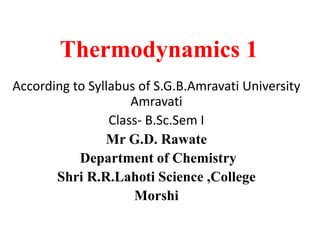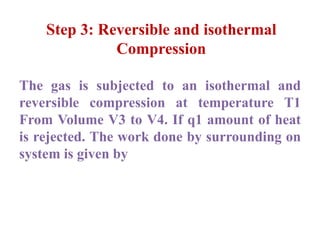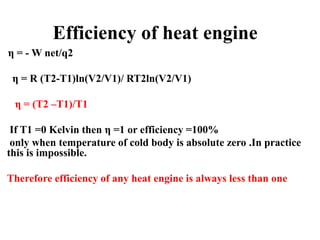The document provides an overview of thermodynamics, covering concepts such as thermodynamic processes (adiabatic and isothermal), the first and second laws of thermodynamics, and the Carnot cycle. It discusses the transformations of energy and the work done in various processes involving ideal gases, while explaining the limitations of the first law and the need for the second law. Detailed mathematical expressions and relations between pressure, volume, and temperature for various processes are also included.













![Relation between pressure and volume
For adiabatic reversible expansion of ideal gas we
have
dU = Cv dT = PdV = - n RT d ln V
CvdT = - n RT dln V ---------------(1)
But for n mole of ideal gas Eq is
PV = n RT on differentiation we get
PdV + V dP = n R dT
dT = (PdV + V dP)/nR
dT = (P/n R)dV +(V/nR)dP [ P=n RT/V &V=n RT/P]](https://image.slidesharecdn.com/thermodynamic-210517123600/85/Thermodynamic-I-14-320.jpg)
![.
dT = (n RT/nR)(d V /V) +(n RT/nR)( dP /P)
dT = T dlnV + T dln P
Putting this value in eq (1)
Cv (T dln V+ Td lnP ) = - nR T dln V
Cv T dln V+ Cv TdlnP = -nRTdln V
Cv T dln P =[ -nRTdln V – Cv T dln V]
Cv T dln P =-(Cv +nR)dln V
Cv dln P = - Cp dlnV
dlnP = -(Cp/Cv)dlnV
But Cp/Cv= ɤ
d lnP = - ɤ dlnV](https://image.slidesharecdn.com/thermodynamic-210517123600/85/Thermodynamic-I-15-320.jpg)
![.
Integrate above eq in suitable limits
∫ dln P = - ɤ ∫ dlnV
[lnP ]p1 = - ɤ [lnV]v1
lnP2/P1 = - ɤ ln V2/V1
lnP2/P1 = ln(V1/V2) ɤ
P2/P1 = (V1/V2) ɤ
P2/P1 = (V1) ɤ/(V2) ɤ
P1V1ɤ = P2V2ɤ = Constant
p2
P1
V1
V2
V2
P2](https://image.slidesharecdn.com/thermodynamic-210517123600/85/Thermodynamic-I-16-320.jpg)

![.
Cv/nR ∫ dln T = dlnV
Cv /n R [ ln T ]T1 =-[lnV]v1
Cv /nRlnT2/T1 = lnV1/V2
But Cv = (C p –nR)
(Cp – nR/nR) ln T2/T1 = lnV1/V2
[ ln(T2/T1)] (Cp -nR/nR) = ln V1/V2
(T2/T1)(Cp-nR /nR) = V1/V2
( T2/T1) = (V1/V2)(nR /Cp-nR)
(T2/T1) = (v1/V2) (Cp -Cv /Cv)
(T2/T1) = (v1/V2)(Cp -Cv /Cv)
(T2/T1) = (V1/V2) (ɤ - 1)
T2V2 (ɤ - 1) = T1V1 (ɤ - 1)
T2V2 (ɤ - 1) = T1V3(ɤ - 1)
T2
V2](https://image.slidesharecdn.com/thermodynamic-210517123600/85/Thermodynamic-I-18-320.jpg)


![.
Cp dln T = nRdln P
dln T = nR/C p dln P
Integrating above Eq within Suitable limit,
∫ dln T = n R/Cp ∫ d lnP
[ln T ] = nR/C p [lnP]
(ln T2/T1) = n R/ Cp ln P2/P1
(T2/T1) = (P2/P1)n R/Cp
(P2/P1) = (T2/T1)C p / nR
(P2/P1) =(T2/T1)C p /C p - C v
(P2/P1) = (T2/T1) ɤ/ɤ -1
(P2/P1) = ( T2 ɤ/ɤ -1 /T1 ɤ/ɤ -1) ɤ/ɤ -1](https://image.slidesharecdn.com/thermodynamic-210517123600/85/Thermodynamic-I-21-320.jpg)






















![.
Similarly along the curve AD
T2V1 (ɤ - 1) = T1V4(ɤ - 1)
(T2/T1) = (V4/V1) (ϒ-1) --------------(7)
Thus From Eq 6 and 7
(V3/V2)(ϒ-1) = (V4/V1) (ϒ-1)
(V3/V1) = (V4/V1)
(V2/V1) = (V3/V4)
Equation (5) becomes
- W net = RT2ln(V2/V1)+RT1ln(V1/V2)
- W net = RT2ln(V2/V1) - RT1ln(V2/V1) ------------(8)
- W net = R(T2 - T1)ln(V2/V1)
Net heat absorbed by the system in complete cycle is given by
q = { Heat absorbed in various Step –Heat rejected in various step}
= [ q2 – q1 ] -----------------------------(9)
Q = (q2 –q1)
But net heat absorbed = Net work performed
q = -W net = (q2 – q1) = R(T2-T1)ln(V2/V1)
-Wnet = q = (q2 –q1 = R (T2 –T1) ln (V2/V1) ---------(10)](https://image.slidesharecdn.com/thermodynamic-210517123600/85/Thermodynamic-I-44-320.jpg)
